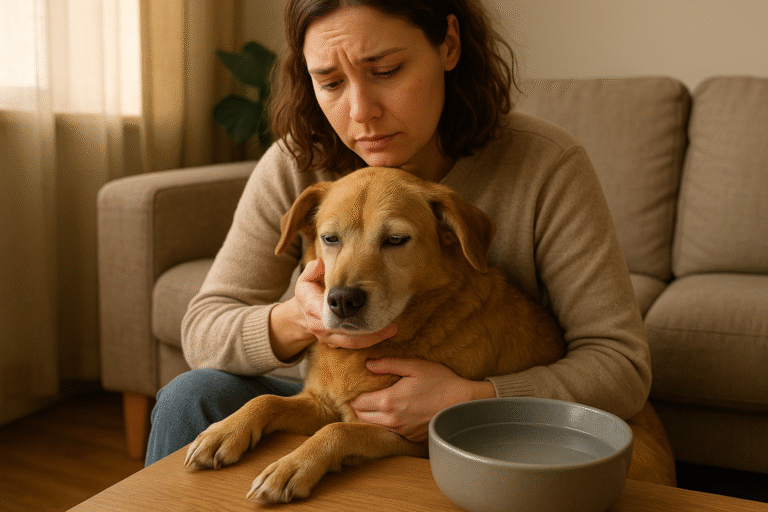Is Chocolate Toxic to Dogs and Cats? Understanding the Danger Levels
Many pet owners are aware that chocolate should be kept away from their furry friends. Yet, few truly understand the science behind why it’s dangerous. The topic of chocolate toxicity in pets—especially dogs and cats—remains one of the most misunderstood areas of pet health. While a piece of chocolate may feel like a comforting treat to humans, it can pose a severe, and often life-threatening, danger to pets.
Table of Contents
ToggleThis article offers an in-depth guide to the danger levels, symptoms, types of chocolate, emergency care, and preventative tips to protect your pets. Whether you are a first-time pet owner or an experienced animal lover, this article will help you understand why chocolate is bad for dogs and cats, and what to do in case of accidental ingestion.
Key Facts
- Chocolate toxicity in pets occurs because animals break down theobromine and caffeine much more slowly than humans.
- The darker the chocolate, the more theobromine it contains—making it significantly more dangerous to pets.
- Not all chocolate is equally harmful—some types pose a much higher risk of poisoning in dogs and cats.
- Ingestion of even a small quantity of certain chocolates can result in serious health complications for your pet.
- Signs of chocolate poisoning can include anything from mild vomiting and diarrhea to severe heart and nervous system issues.
- Quick action and professional veterinary care are critical if your pet is suspected to have consumed chocolate.
- Preventing access is the best safeguard—always keep chocolate and cocoa products safely out of pets’ reach.
Is Chocolate Toxic to Dogs and Cats? Understanding the Danger Levels
Within the realm of pet ownership, ensuring the health and safety of our beloved animal companions remains a paramount concern. While we often share our lives and homes with dogs and cats, it is crucial to recognize that their physiological responses to various substances can differ significantly from our own. One such substance, commonly enjoyed by humans yet potentially perilous for our furry friends, is chocolate. Consequently, a thorough understanding of chocolate toxicity in pets, particularly dogs and cats, becomes indispensable for responsible pet care.
The question, “Is chocolate bad for dogs?” is one frequently posed by concerned pet owners, and rightfully so. Chocolate, a seemingly innocuous treat for humans, harbors compounds that can pose a significant threat to the well-being of our canine and feline companions. To fully grasp the potential dangers, it is essential to delve into the specific components of chocolate that render it toxic to pets, the varying levels of risk associated with different types of chocolate, the clinical signs of chocolate poisoning, and the necessary steps to take in the event of ingestion.
The Culprits Behind the Toxicity: Theobromine and Caffeine
At the heart of chocolate’s toxicity in dogs and cats lie two methylxanthines: theobromine and caffeine. These substances act as stimulants on the central nervous system and cardiovascular system. While humans possess the metabolic pathways necessary to efficiently break down and eliminate these compounds, dogs and cats metabolize them much more slowly. This slower metabolism leads to a buildup of theobromine and caffeine in their systems, resulting in a range of adverse effects, the severity of which depends on the amount and type of chocolate consumed, as well as the size and sensitivity of the individual pet.
Theobromine, in particular, is present in higher concentrations in chocolate compared to caffeine and is considered the primary toxic agent for pets. Its effects can include increased heart rate, elevated blood pressure, tremors, seizures, and in severe cases, even death. Caffeine, while present in smaller amounts, can contribute to the stimulant effects and exacerbate the overall toxicity.
Types of Chocolate and Their Toxicity Levels
| Chocolate Type | Theobromine Content (mg/oz) | Toxicity Level |
|---|---|---|
| White Chocolate | 0.1 – 0.5 | Low (but still risky) |
| Milk Chocolate | 44 – 64 | Moderate |
| Dark Chocolate | 130 – 160 | High |
| Baking Chocolate | 390 – 450 | Extremely High |
| Cocoa Powder | 400 – 737 | Extremely High |
Varying Levels of Danger: Understanding Different Types of Chocolate
It’s important to understand that chocolate toxicity in pets varies depending on the type of chocolate consumed. The theobromine concentration changes based on cocoa content, making it vital for pet owners to know the differences to accurately evaluate the level of risk.
Cocoa Powder: As the most concentrated source of theobromine, cocoa powder poses the greatest danger in terms of chocolate toxicity in pets. Even minimal exposure can result in serious symptoms. Although its strong taste may prevent excessive consumption, even a small amount can be hazardous.
Unsweetened Baking Chocolate: Much like cocoa powder, unsweetened baking chocolate contains high cocoa solid levels, leading to elevated theobromine content. Just a small amount can lead to severe toxic reactions, making it one of the most dangerous chocolate types for pets.
Dark Chocolate: With a higher cocoa content than milk chocolate, dark chocolate significantly increases the risk of chocolate toxicity in pets. Though its bitterness might reduce appeal to animals, its potency means even limited ingestion can cause major health concerns.
Milk Chocolate: While it contains less theobromine than darker varieties, milk chocolate still raises concerns. It’s sweeter and more tempting to pets, which can lead to overconsumption. For smaller pets especially, the answer to is chocolate bad for dogs remains a clear yes, even with milk chocolate.
White Chocolate: White chocolate contains the least theobromine because it lacks cocoa solids, relying mainly on cocoa butter, sugar, and milk. Although it poses a lower toxicity risk, its high fat and sugar content can still upset a pet’s digestive system and should be avoided.
Factors Influencing Toxicity: Dosage and Individual Sensitivity
The severity of chocolate poisoning in pets is influenced by several factors, most notably the dose of theobromine ingested relative to the pet’s body weight. Smaller dogs and cats are generally more susceptible to the toxic effects because the same amount of chocolate will result in a higher concentration of theobromine in their system compared to larger animals.
Furthermore, individual sensitivity can play a role. Some pets may be more sensitive to the effects of methylxanthines than others, exhibiting more pronounced symptoms even with smaller amounts of chocolate ingestion. Underlying health conditions, such as heart problems, can also increase the risk of severe complications.
Recognizing the Signs: Clinical Manifestations of Chocolate Poisoning
The clinical signs associated with chocolate toxicity in pets depend on several factors, including the type and quantity of chocolate consumed, as well as the pet’s individual sensitivity. Symptoms typically begin within a few hours after ingestion and can range from mild to life-threatening.
Mild Symptoms: When exposure is minimal, pets may experience gastrointestinal issues such as vomiting, diarrhea, abdominal pain, or reduced appetite. They may also seem unusually restless or overly energetic, which are early indicators of chocolate toxicity in pets.
Moderate to Severe Symptoms: With increased theobromine intake, more serious effects may occur. Pets can develop a rapid heartbeat, high blood pressure, muscle tremors, excessive urination, and twitching. In some cases, neurological symptoms like loss of coordination or seizures may present. The most critical cases of chocolate toxicity in pets can escalate to dangerous cardiac arrhythmias, respiratory distress, or even be fatal.
It’s important to understand that even if your pet seems normal after eating chocolate, symptoms can develop later. Pet owners wondering is chocolate bad for dogs should know that any ingestion warrants close observation and possibly prompt veterinary care.
Immediate Action is Crucial: What to Do If Your Pet Eats Chocolate
If you suspect that your dog or cat has ingested chocolate, prompt action is paramount. Do not wait for symptoms to appear before seeking veterinary assistance. The following steps should be taken immediately:
- Assess the Situation: Try to determine the type and amount of chocolate your pet has consumed, as well as the approximate time of ingestion. This information will be crucial for your veterinarian in assessing the potential risk.
- Contact Your Veterinarian Immediately: Call your veterinarian or a pet poison control hotline without delay. Provide them with the details you have gathered about the type and amount of chocolate ingested, as well as your pet’s weight and any observed symptoms. They will be able to provide specific guidance based on the situation.
- Follow Veterinary Advice: Your veterinarian or the poison control center will advise you on the next steps. This may involve bringing your pet in for an examination and potential treatment. Do not attempt to induce vomiting at home unless specifically instructed to do so by a veterinary professional, as it can sometimes do more harm than good.
- Be Prepared for Veterinary Intervention: Depending on the amount and type of chocolate ingested and the time elapsed since ingestion, veterinary treatment may include inducing vomiting (if appropriate and recent), administering activated charcoal to help absorb the toxins, and providing supportive care such as intravenous fluids and medications to manage symptoms like tremors, seizures, and cardiac abnormalities.
Prevention is Key: Protecting Your Pets from Chocolate Toxicity
The most reliable way to safeguard your pets from the dangers of chocolate toxicity in pets is through prevention. Taking proactive steps to eliminate any opportunity for exposure can greatly reduce the risk of harmful ingestion.
- Secure All Chocolate Products: Store all forms of chocolate—including cocoa powder, baking chocolate, dark and milk chocolates, and items containing chocolate like desserts or candies—in sealed containers. Place them in cabinets or storage areas completely out of your pet’s reach, avoiding countertops or tabletops where dogs or cats may jump.
- Inform Family and Visitors: Make sure everyone in your home, including guests, understands the risks of chocolate toxicity in pets. Reinforce the message that feeding chocolate to pets is dangerous and should never be done.
- Be Extra Careful During Festive Seasons: Holidays like Christmas, Halloween, and Easter often involve more chocolate in the household. Stay alert during these times to avoid accidental pet exposure to toxic treats.
- Never Leave Chocolate Unattended: Avoid leaving any chocolate items where your pets could access them, even briefly. Pets are naturally curious, and unattended food is an open invitation for a quick bite.
- Teach Kids About Chocolate Safety: Help children understand the answer to is chocolate bad for dogs by educating them early. Teach them that sharing chocolate with pets, no matter how loving the gesture, can lead to serious harm.
Following these simple but essential precautions can protect your furry companions from the serious and sometimes fatal effects of chocolate toxicity in pets, giving you peace of mind and ensuring their well-being.
Conclusion: A Treat for You, a Hazard for Them
In conclusion, while chocolate remains a beloved treat for humans, it poses a significant and potentially life-threatening risk to our dogs and cats. The presence of theobromine and caffeine, compounds that pets metabolize slowly, renders chocolate toxic. The level of danger varies depending on the type of chocolate, with darker varieties containing higher concentrations of theobromine and thus posing a greater threat.
Recognizing the clinical signs of chocolate poisoning and acting swiftly in the event of ingestion are crucial for ensuring the best possible outcome for your pet. However, the most effective approach is prevention. By understanding the dangers and taking proactive steps to keep all chocolate products out of reach, responsible pet owners can safeguard the health and well-being of their cherished animal companions. Ultimately, remembering that what is a delightful indulgence for us can be a serious hazard for them is paramount in fostering a safe and healthy environment for our furry family members.
Frequently Asked Questions (FAQs)
1. What makes chocolate toxic to pets?
2. How much chocolate is dangerous for dogs and cats?
The toxic dose depends on the pet’s weight and the type of chocolate. As little as 20 mg/kg of theobromine can cause mild symptoms, while doses over 60 mg/kg can be fatal. Dark and baking chocolates pose the highest risk.
3. Is chocolate bad for dogs even in small quantities?
Yes. Even small amounts can cause chocolate toxicity in pets, particularly in small dogs or when dark or baking chocolate is involved. Always treat any ingestion as a potential emergency.
4. What are the symptoms of chocolate poisoning in pets?
Common signs include vomiting, diarrhea, rapid heart rate, restlessness, muscle tremors, and in severe cases, seizures or coma. Symptoms usually appear within 6–12 hours after ingestion.
5. Can cats get sick from eating chocolate too?
6. What should I do if my pet eats chocolate?
Contact your veterinarian immediately. Provide details about the type and amount of chocolate consumed, the time of ingestion, and your pet’s weight. Do not wait for symptoms to appear.
7. How is chocolate toxicity treated in pets?
8. Which type of chocolate is most toxic to pets?
9. Can white chocolate harm dogs and cats?
10. Why are dogs more at risk than cats?
Dogs are more likely to eat chocolate due to their strong sense of smell and less selective eating behavior. Cats are more cautious eaters, but if chocolate is consumed, the risks are equally serious.
11. Are there pet-safe alternatives to chocolate?
12. Can chocolate ingestion cause long-term health problems in pets?
13. Are there any online calculators to estimate toxicity risk?
14. How can I prevent my pet from eating chocolate?
Store chocolate in secure, out-of-reach places. Educate children and visitors, avoid sharing human treats, and be extra cautious during holidays when chocolate is more accessible.
Recent Posts









Related Topics
Copyright © 2025 The Pet Blog – Expert Tips, Care Guides & Fun Facts for Every Pet Lover.

